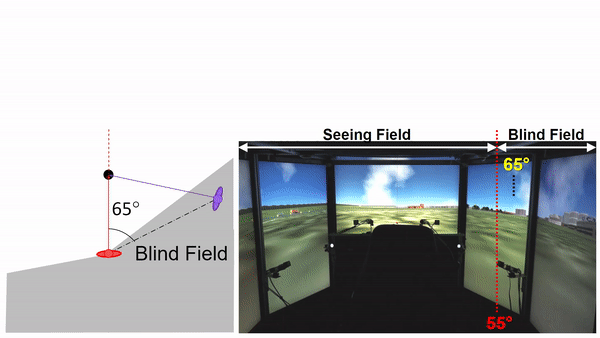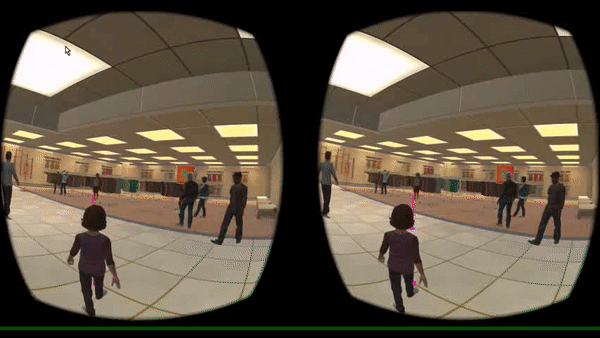
We use pedestrian collision detection and judgment performance to evaluate the impact of various factors on visual confusion and rivalry in field expansion. We have developed a VR walking simulator scenario using our driving simulator and tested it with field expansion visual aids. An open space VR walking environment (walk in the park) is simulated using our driving simulator, which provides a 225° FoV. The simulated pedestrians initially appear at bearing angles from the subject of 10°-45°. They are either on a collision course with the patient (time-to-collision 6s) or designed to pass behind or in front of the patient. The speeds of both patient and pedestrian are fixed (though different) for each event. Patients press the horn when they first detect the pedestrian. Both the detection rate and response time are recorded.

We develop a new VR walking simulator using the Unity game engine on HMD. The new walking simulator will present a crowded airport terminal or shopping mall scene with multiple pedestrians in each scene. The subject will be asked to look at the lead person. Multiple pedestrians will be continuously present appearing at various bearing angles and courses.
Grants
09/2020 – 08/2024, Monocular Visual Confusion for Field Expansion, NIH/NEI R01 – EY031777 (PI)
09/2019 – 08/2024, Visual field expansion through innovative multi-periscopic prism design, NIH/NEI R01- EY023385 (Co-Investigator)
07/2018 – 12/2019, Field Expansion for Acquired Monocular Vision using Multiplexing Prism, Fight for Sight Grant #GA18003 (PI)
09/2013 – 08/2019, Visual field expansion through innovative multiplexing prism design, NIH/NEI R01- EY023385 (Co-Investigator)
Publications
Han S, Kim S, Jung J-H. (2023). The effect of visual rivalry in peripheral head-mounted displays on mobility. Sci. Rep. Submitted.
Hwang A, Peli E, Jung J-H. (2023). Development of Virtual Reality Walking Collision Detection Test on Head-mounted display. Proc. SPIE 12449, Optical Architectures for Displays and Sensing in Augmented, Virtual, and Mixed Reality (AR, VR, MR) IV, 124491J. Publisher’s Version
Kim S, Han S, Jung J-H. (2023). Binocular see-through configuration and eye movement attenuate visual rivalry in peripheral wearable displays. Proc. SPIE 12449, Optical Architectures for Displays and Sensing in Augmented, Virtual, and Mixed Reality (AR, VR, MR) IV, 124490T. Publisher’s Version
Jung, J. – H., Kurukuti, N. M., & Peli, E. (2021). Photographic Depiction of the Field of View with Spectacles-mounted Low Vision Aids. Optometry and Vision Science , 98 (10), 1210-1226. Publisher’s Version
Jung, J. – H., Castle, R., Kurukuti, N. M., Manda, S., & Peli, E. (2020). Field Expansion with Multiplexing Prism Glasses Improves Pedestrian Detection for Acquired Monocular Vision. Translational Vision Science & Technology , 9 (8), Article 35. Publisher’s Version jung_2020_tvst.xlsx
Qiu, C., Jung, J. – H., Tuccar-Burak, M., Spano, L., Goldstein, R., & Peli, E. (2018). Measuring Pedestrian Collision Detection With Peripheral Field Loss and the Impact of Peripheral Prisms. Translational Vision Science & Technology , 7 (5), 1-1. Publisher’s Version
